- NYSD: The tortoise and the hare at Skelton Castle - August 28, 2025
- Green Moor lift Billy Oates Memorial Cup at Hill Top Lane - August 13, 2025
- One weekend, short games: Kirkheaton & Upper Haugh excel - July 29, 2025
Some cricket grounds you drive past, and think: “One day, I must watch a game there.”
Thirty-odd years ago, I was domiciled in Great Ayton (on reflection, I’m not sure I’ve lived anywhere nicer), and hiked regularly on and around the North Yorkshire Moors.
Many journeys to walk starting points took me along the Easby to Commondale minor road, next to which, about four miles from ‘Canny Yatton’, the bucolic Kildale Cricket Club ground is located.
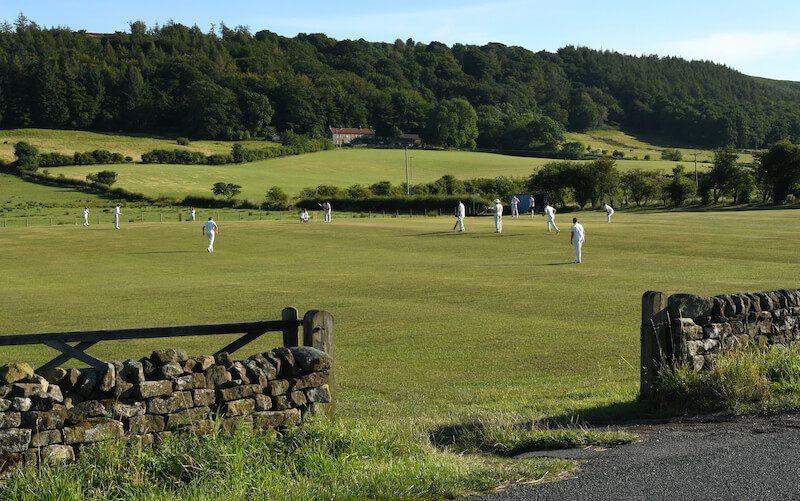
The ground’s abundant charm and scenic setting always appealed. Finally, come the high summer of 2025, I made it to Kildale for a cricket match. And loved the experience!
Interested to discover ‘Kildale’ derives from ‘Childale’, Viking words for ‘narrow valley’. I don’t know what sort of valleys they have in Denmark but compared, say, to the narrow valleys and cloughs of the South Pennines, the upper valley of the River Leven, in which Kildale lies, strikes me as decidedly broad.
The cricket ground, its undulating pitch a series of gentle green ripples, occupies the flat valley floor, about a third of a mile east of the attractive Kildale village.
Its surroundings took me straight back to A-Level physical geography. Surely, U-shape and all, akin to neighbouring Esk Dale, there cannot be a more obviously glacially eroded creation than the upper Leven valley.
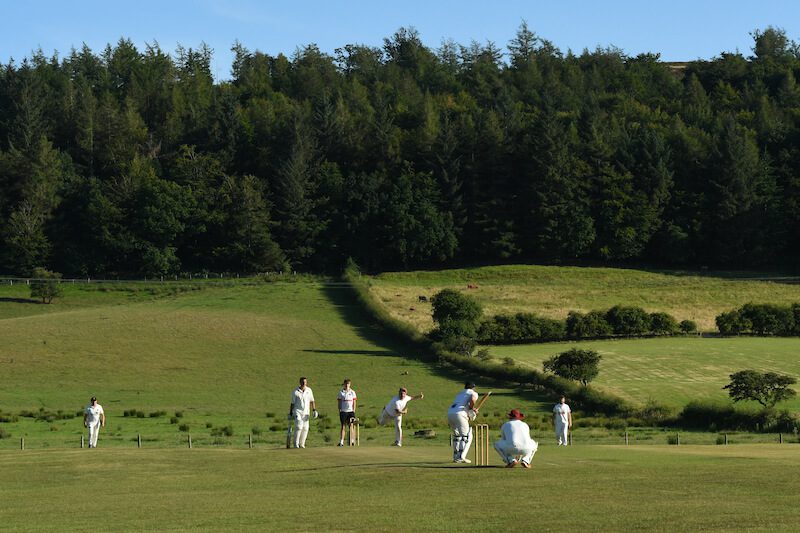
Both steeply sloping flanks of the valley are topped by woodland (evergreens, in the main, I’d say), providing a sombre backdrop to the cricket.
Kildale Cricket Club were formed in 1902. Their badge, an eye-catching scarlet and gold splash on the players’ white shirts, features a castellated tower.
This, I assume, is a nod to the former Kildale Castle, built during the 1100s by the unimaginably wealthy Percy family.
The Percys, Earls of Northumberland, are one of a mere handful of former owners of the Kildale Estate (mostly, moors and woods), in which the cricket ground is located.
Eventually, the castle was replaced by a manor house. All that remains of either are mounds in fields near Kildale’s mid-Victorian church, dedicated to St Cuthbert.
A hundred yards or so beyond the cricket ground’s northern perimeter is the Esk Valley railway line (from the nearer boundary rope, the line’s occasional trains are heard rather than seen), which links – tortuously if prettily – Middlesbrough and Whitby.
Apparently, the railway, which came to Kildale in 1858, bisects a stretch of the abandoned moat that surrounded the castle.
Beyond the railway, visible from the cricket ground, is the hamlet of New Row, little more than a short row of stone cottages.
Built between 1865 and 1867, by the Lonsdale Mining Company, the cottages were occupied originally by mineworkers and their families. The formerly semi-industrial Kildale district was noted for the mining of ironstone, jet, and whinstone.
The cricket ground is part of Kildale Sports Field, which the cricketers share with Kildale Football Club, who until 2024 played in the Hambleton Combination.
The overlapping football pitch is at the sports field’s east end. During the cricket season, its turf provides plentiful and safe (from potentially damaging projectiles) parking for players and spectators.
Jefferson Cup at Stokesley
Worth a mention: one of Kildale Football Club’s finest moments came in 1952, when they beat Great Broughton, 5-2, in the final of the Jefferson Cup, a showpiece played that season at what is now North Yorkshire & South Durham Premier League Stokesley Cricket Club’s Broughton Road ground.
The Great Broughton XI included future England forward Brian Clough and two of his brothers (back home, in Middlesbrough, Clough was the sixth child of nine).
Having secured a glowing report from Boro legend, ‘Gentleman’ George Hardwick, on scouting duties at the cup final, Clough signed for Middlesbrough the following day.
A wooden gate provides access, from the Easby to Commondale road, to Kildale Sports Field. The small cricket pavilion, in its northwest corner, has an unusual history.
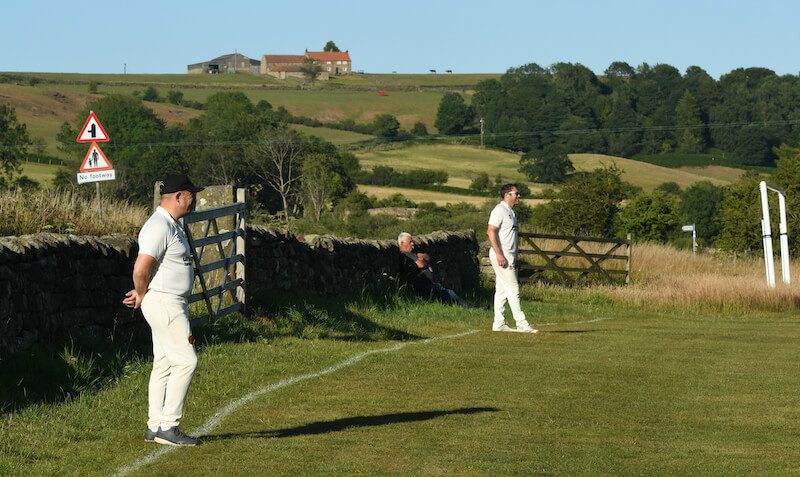
I gather the pavilion began life as a prefabricated bungalow. Kildale Cricket Club bought it, for £800, in 1988. The club secretary, the late Alan Peirson, and seven others, each loaned the club £100. Not, I suspect, with any intention of seeing the money repaid.
The pavilion’s predecessor, a wooden structure, was transported to the sports field on the back of a milk lorry – but only having been sawn in half!
A scattering of benches alongside the pavilion, which has a club room, a changing room and a loo, includes one bearing a memorial plaque to Alan, who died in 2012 after decades of selfless service, in various capacities, to Kildale Cricket Club.
The idiosyncratic nature of the pitch ensures that, from the north end boundary, a fielder opposite is visible only from the waist up.
Keen to make a day of it, we (my wife and I) had earlier motored into the head of Danby Dale via Helmsley, Hutton-le-Hole, and the spectacular Blakey Ridge.
Lunch was taken at a favourite eaterie: the café at the Camphill Village Trust’s Botton Village, a Malton-based charity not only supporting and providing social care for adults with learning disabilities and mental health problems, but also offering to visitors delicious food and drink, from homegrown ingredients, at value-for-money prices.
The Botton Village café’s soup of the day, red pepper and tomato, was a piquant taste sensation, and its Rocky Road cake amongst the finest sweet treats I’ve encountered.
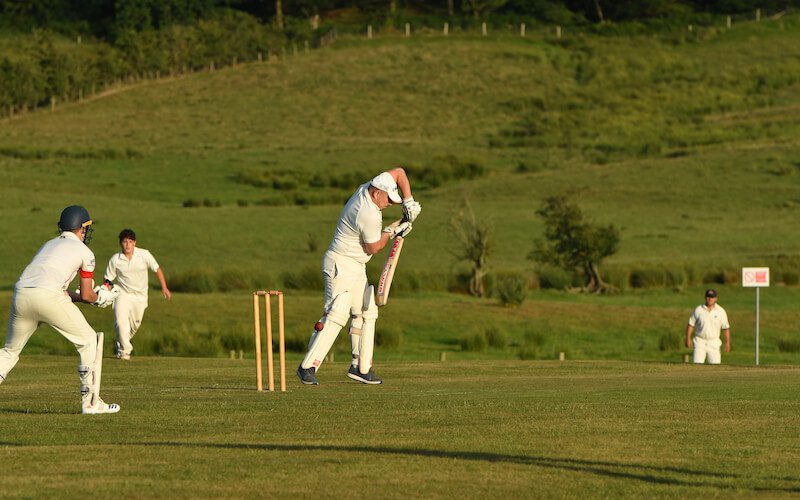
Pausing in Castleton, to promote leisurely digestion and to admire the splendid view across Esk Dale from High Street, we got chatting to a chap with an Antipodean accent.
Turned out he was a New Zealander, enjoyed a three-month, later-in-life overseas experience, and staying at nearby Lealholm for a few days.
When we mentioned we were off to watch Esk Valley Evening League cricket later, he asked if Lealholm had a team.
“Yes,” I replied, “and they’re at home tonight.” He vowed to seek out the cricket ground.
We had the better game, because Lealholm, second in the league’s West Section, at the start of play a point behind pacesetters Kildale, trounced Castleton by 10 wickets.
Over at Kildale, we witnessed a home win – by five wickets, with just three balls to spare – over fourth-placed Egton.
The evening’s results left Kildale still a single point ahead of Lealholm as the Esk Valley Evening League’s West Section season reaches its climax between now and Wednesday, August 6.
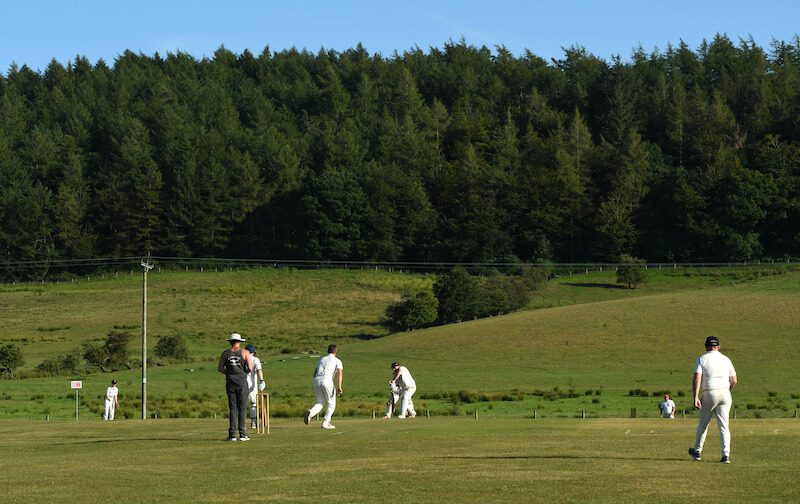
Having won the toss, beneath a cloudless, brilliantly blue sky, Kildale opted to bowl.
In the lee of the Cleveland Hills, we couldn’t get a mobile signal. Probably why the scorers were scoring manually, using those once-familiar rectangular scorebooks.
Opener Joe Lenton struck 55 off 63 balls (eight fours) and Sam Webster, in at number five, 20 off 15 (one six, one four) as Egton saw out their 20 overs at 118-7.
Michael Croft returned an impressive 2-8 from two overs, with Tom Collins picking up two wickets for 30, from four.
The excitement and tension generated during the Kildale reply diverted our attention from lengthening shadows and a falling temperature.
Kildale were 26-1 after five overs, 54-2 after 10, and 87-2 after 15. Thirty-two runs were required from the last 30 balls.
It was nip and tuck, with Egton fielders urged to maintain concentration. “Keep it nice and tight in there, lads.” Followed by: “Come on, boys. We’ve got to tidy up.”
One fielder, adopting the role of human shield, put his body on the line to prevent what looked a nailed-on four. “I stopped that with my balls,” he grimaced whilst massaging.
The 17th over gave Egton, six of whose players play only in midweek, renewed hope.
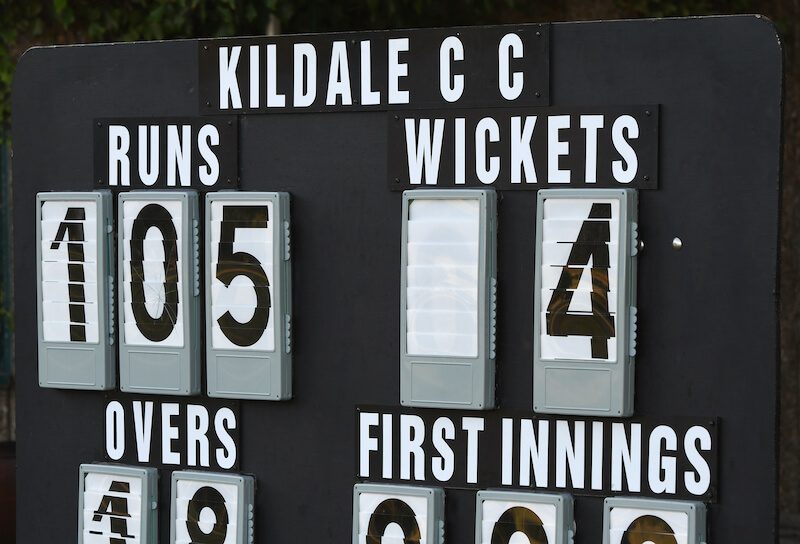
Spinner Alfie Harrison (2-12 from two) took two wickets then prompted a loudly confident yet rejected ‘LB’ appeal. “Great bowling, Alfie, son,” saluted a team-mate.
But Will Rice, who came in at number four, was the batter Egton needed to dismiss.
In T20 terms, Rice proceeded with considerable caution, shunning risky second runs and waiting to punish the bad ball, although he did play and miss a few times.
In the end, though, the indefatigable Rice steered Kildale to a thrilling victory.
With the pressure mounting, a Rice six, off the third ball of the penultimate over, just cleared the outstretched hands of a boundary fielder. A crucial moment!
Eight runs were needed from the evening’s final over. The confident Rice despatched its first delivery with a monster hit, the ball arrowing down the ground, high above our heads, before clearing the road and falling to earth in an adjacent field.
A couple of balls later, with the scores tied, Rice bludgeoned a straightish four to advance Kildale to 122-5 and a five-wicket victory. Rice finished unbeaten on 62 (off 49 balls, five sixes, four fours).
Extras and bottled beer
In a contest of fine margins (Egton were left to rue conceding a few too many wides), Kildale opener James Burns contributed a restrained 27 (off 48).
The players certainly deserved the bottled beer broken out as soon as they returned to the pavilion!
Good to see cricket’s traditions of sportsmanship maintained: no matter how many runs were scored, each batter was applauded off – by the players of both teams.
There is a potential Esk Valley Evening League West Section title decider on July 30 (6.30), when Lealholm entertain Kildale, the latter defeated, at home to Moorsholm, on April 30, only once in 2025.
The previous Wednesday, July 23 (6.30), Lealholm host Moorsholm, who are third, also with just once loss, at Egton, on May 21, and in hot pursuit.
I wonder what will be on the menu, July 23 and July 30, at the Botton Village café?
Enjoyed the read?
You can check out other club visits by Andrew in his column, Miles Per Gallon.
Here are all of our club cricket articles, with the latest first.